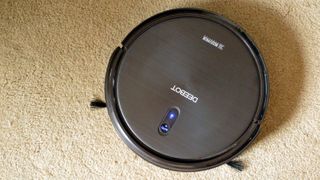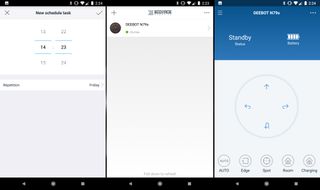TechRadar Verdict
The Ecovacs Deebot N79S looks good and is pretty easy to set up. It's great at picking up small messes you've left behind, but if you’re looking for something more futuristic-looking or a vacuum that can deliver a deep clean each and every day this might not be the right vacuum for you.
Pros
- +
App works well
- +
Easy to use
- +
Works great with Alexa
Cons
- -
Not very thorough
- -
Not compatible with many smart home services
Why you can trust TechRadar
Cleaning is a real pain in the butt. While handheld vacuums have been getting a whole lot better recently, as demonstrated by the new Dyson V10, there’s one thing that most vacuums have in common: they take effort to use.
That, however, is where robotic vacuums come in.
It would be easy to assume that robotic vacuums were quick to adopt new smart home standards, but assuming that would be incorrect. In fact, it wasn’t until recently that we started seeing Alexa and Google-enabled vacuums at all, let alone any vacuums that can be automated with the rest of your home.
The Ecovacs Robotics Deebot N79S is one of those new vacuums. It can be controlled through an app, integrates with Alexa, and actually works pretty well ... in specific situations.

Design
At first glance, the Deebot N79S doesn’t look all that special, especially if you’re used to seeing gleaming, futuristic-looking robotic vacuums. That’s not to say it’s ugly – in fact, it’s pretty sleek. It’s just not what we think most people picture when they hear the words robot vacuum cleaner.
On the front of the device, you’ll find an array of sensors, as well as a series of guards aimed at protecting the device in the event of a collision with the wall. On the top, there’s one button, which allows you to put the vacuum in auto mode, where it will simply wander around and vacuum the house, or to turn it on and off.
On the bottom, you’ll attach two side-brushes, which help to brush the dirt and dust into the vacuum itself. The side-brushes are partially why the vacuum is really only built for hard-wood or short-carpet floors – on longer carpets, they’ll get bent out of shape pretty quickly.

When you first set up the vacuum, you’ll need to charge it and download the app where you’ll register and connect to the vacuum. In general, this setup process should be pretty easy.
The vacuum also comes with a small dock, which you’ll need to find a space for along the wall somewhere. This is where the vacuum will live and charge when you’re not using it.
As is the case with any new gadget, you’re probably going to be pretty interested in how it works, and for us that meant following it around the first few times we used it. Since the vacuum lives upstairs, we were very interested to see how it would handle with steep steps. The result? Each time it looked like it was about to fall to its death, it slowly backed up and prevented an accident. If our tests are any indication, you have no reason to fear your new investment taking a tumble anytime soon.
The vacuum also comes with a remote, though, considering you can control the vacuum with you phone, you probably won’t need it.
If you choose to use it, the remote is very easy to use - you can use it to manually control the vacuum, or to set the device to a particular mode. It has a display that shows the time and the mode that you’re using, and we found that the vacuum was actually rather responsive to the remote as opposed tot the app.

The app
The app is well-designed. When you first open it up, you’ll see a list of vacuums you have - though, for most, there will only be one vacuum on that list. Tap it, and you’ll be able to manually control the vacuum using directional buttons, or set it to a mode. There are a few modes to use. Here’s a quick rundown.
- Auto mode is aimed at being the most efficient at cleaning the entire house. It’ll vacuum in straight lines, and then when it hits an obstacle, it’ll change direction.
- Edge mode sets the vacuum to clean around the edges and corners of your room.
- Spot mode is built to clean a specific segment of the floor, and when you use it the vacuum will start in a spot and vacuum out in a spiral.
- Room mode is very similar to auto mode, but it’s aimed more at cleaning a specific room rather than the house in general.
When you’re done vacuuming, the fifth button tells the vacuum to return to its charging station.
Through the app, you’ll also be able to see how much battery the vacuum has, and you can schedule the vacuum to turn on at certain times – ideally when you're away at work or out running errands. The app doesn’t look all that beautiful, but it serves its purpose perfectly well and we found it was very easy to use.
Performance
In general, the vacuum does its job ... but don't think your days of cleaning are past you. Even though the N79S is pretty good at cleaning your carpet, it’s not all that good at staying clean itself.
One of the things that we found had to be cleaned pretty regularly was the roller on the bottom. Cleaning it is relatively easy to do - but it was still annoying. And, of course, you’ll also have to clean out the dust compartment.
Another issue that we had is that the vacuum isn’t always that great at staying out of trouble. For example, it’s able to get under some furniture, but for furniture that’s just too low, it might get wedged underneath, at which point you’ll have to go and rescue it. That didn’t happen to us all that often, but it still happened on more than one occasion during our testing.

That also kind of means that if you plan on running the vacuum when you’re out of home, you may come home to find it stuck underneath some furniture and not at its charging station, where it should be.
Apart from those hiccups, when the Deebot N79S didn't get stuck, it actually worked quite well. It doesn't do a serious deep clean but it’s good at picking up most dust and dirt on both shorter carpets and hardwood floors – it's not going to replace a solid afternoon of mopping a hard floor or a professional clean of your carpet, but it does fine at the basics.
It's also pretty darn quiet, too. You could set it to vacuum at night, and as long as it wasn’t the cleaning the bedroom, we doubt it would wake anyone up.
Smart Home Integrations
Perhaps the best reason to buy this vacuum over another is the integration it has with Alexa, and that integration works great. You’ll be able to use commands like “Alexa, ask Deebot to start cleaning,” or “Alexa, ask Deebot to start charging,” and in our testing the vacuum responded immediately to those commands.
The only downside? The vacuum doesn’t really work with any other smart home systems. If you use Google Assistant more than Alexa, you might have problems getting the Deebot N79S to respond to voice commands as we did.
Beyond that, the vacuum doesn’t work with the likes of Samsung SmartThings, Wink, HomeKit, Nest, or anything else - meaning you can’t really automate the vacuum to turn on when, for example, Nest detects that you’ve left the house for the day.
Verdict
The Ecovacs Deebot N79S is a great way to dip your toe into smart robotic vacuums without spending too much money. If your smart home is limited to Amazon’s growing ecosystem and you don’t mind the fact that the vacuum will need a solid cleaning every now and then, then it’s a great option. It’s easy to use, generally good at cleaning most dust and dirt, and works very well with Alexa or the Ecovacs app.
But it’s not for everyone. If you’re a Google, Apple, Nest, Samsung, or Wink user that plans on integrating a vacuum into your smart home or you're someone who wants a deep clean each and every day, then you’ll need to turn elsewhere.
- Don't miss our picks of the best vacuum cleaners
Christian is a writer who's covered technology for many years, for sites including Tom's Guide, Android Central, iMore, CNN, Business Insider and BGR, as well as TechRadar.

